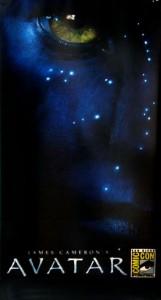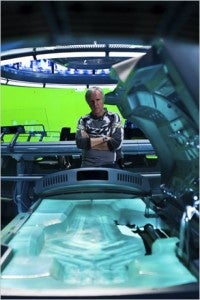
Once you’ve directed the highest grossing movie ever you can afford taking your time with future projects. James Cameron has waited more than 14 years to get his latest creation, AVATAR, into theaters. The director of Terminator, Aliens, and The Abyss, Cameron is no stranger to science fiction, and the recent Comic Con previews in San Diego revealed that Cameron has spared no expense in creating the next scifi epic that will redefine the movie-making process. AVATAR utilized a new technique to merge recorded and synthetic images, allowing Cameron to alter and edit a blend of the two in real-time. The results? The AVATAR movie is a mind-blowing 3-D experience of a futuristic war on a distant alien planet, full of lush environments and unparalleled special effects.
Cameron specifically set out to create a project that would test the limits of digital animation in 3-D and IMAX. As such, AVATAR is set in the far future when humanity is exploring distant planets using life-like artificial bodies called avatars. These avatars enter into a conflict on the exotic world of Pandora inhabited by human-like aliens called Na’vi. These aliens are ten-feet tall, blue, sexy, and a composite of actor’s movements and digitalized appearance. Whether or not the story will wow me, I’m impressed by the potential for amazing digital effects.
When it comes to the Na’vi aliens, Cameron and his team have put a lot of work into making AVATAR a success. Besides the virtual camera filming technique, a completely new language was invented and taught to actors. Movement coaches allowed alien characters to move naturally in non-human patterns. Composer James Horner has choirs of aliens singing during the soundtrack. When you watch AVATAR’s alien environment you are going to be immersed in the Na’vi’s world and culture. The blend of familiar and foreign in space is something that Cameron does well (as seen in Alien) and you can trust in his blockbuster effort to make this film impressive to even the most jaded of science fiction movie-goers.
A new way of making movies
Maybe the intrigue of learning how those brain-melting special effects were created can get you out to the theatre even if the promise of 3-D alien scapes cannot. Cameron’s new filming technique works something like a video game. In traditional CGI scenes, motion capture is used on actors, and the images are blended into synthetic environments in post-production. In AVATAR, Cameron uses a virtual camera to explore how characters look in the environment as they are being filmed. In other words, the director can see and manipulate the final product while he is still shooting the movie. This allowed Cameron to find the most realistic camera angles, the most intense movements, and the right flow between recorded and artificial.
I get the feeling that Cameron isn’t just aiming for the next billion dollar grossing movie, he’s also out to set a standard for how digitalized movies will be recorded. Reportedly he invited Steven Spielberg, Peter Jackson, and George Lucas to explore the technology while he shot the film. (Tactful, no?) 30 years ago, Lucas and the original Star Wars trilogy changed the way that special effects were used in Hollywood. 10 years ago, the second Star Wars trilogy ushered in digital filming and screening. Now, Cameron and AVATAR look to introduce the next industry trend.

Of course, blending recorded and synthetic environments in real-time isn’t a completely new concept. Augmented Reality from Total Immersion has done similar work for baseball cards, business presentations, and advertisements. In fact, AVATAR and Total Immersion are teaming up for an interactive movie marketing campaign, similar to the online AR demonstrations for the latest Star Trek movie. AVATAR is certainly the first full-length feature film to use this technology during main production, post-production, and advertising.
Hollywood has been making the slow transition to green screens, CGI, and digital animation. Audiences only accept this transition when they can believe the reality of what they see on screen. Though there have been some stumbles (Van Helsing, anyone?) the trend is continuing towards completely digitalized entertainment that is as life-like as classically recorded film. AVATAR is likely to be another great step into the next stage of movie-evolution. Not only will it have an incredible alien world for audiences to experience, it will forever change how directors use digital animation. By giving directors another tool to help create more realistic digital scenes, James Cameron has edged us closer to science fiction that seems completely real. Whether or not AVATAR is ultimately a success though, Cameron’s changes to the industry will likely be titanic.


